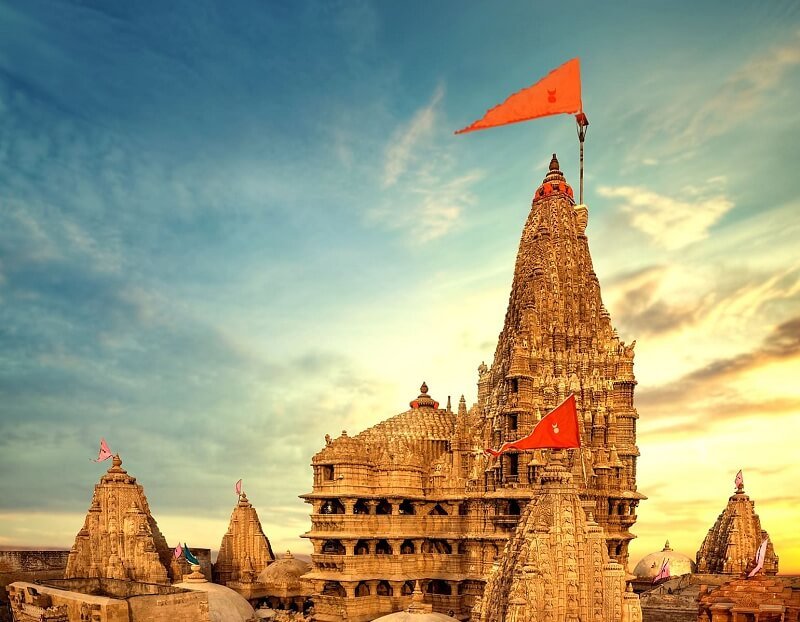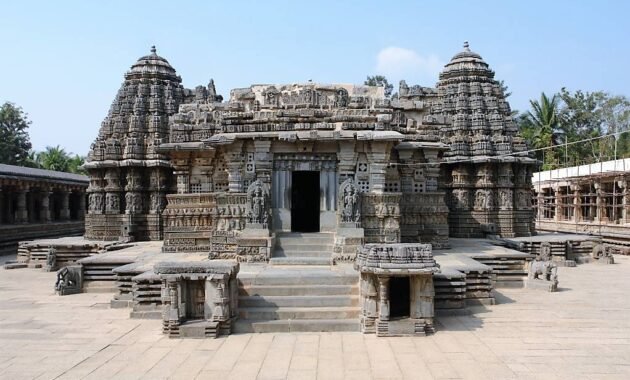India, a land saturated with otherworldliness and rich social legacy, is home to a portion of the world’s most established sanctuaries. These building ponders feature the country’s old strict practices as well as act as a demonstration of the craftsmanship and dedication of individuals who constructed them.
5.Oldest Temples in India: Discovering Ancient Spiritual Marvels
1.Dwarkadhish Temple, Dwarka

About The Place: The main draw for tourists coming to Dwarka, the Dwarkadhish Temple (Jagat Mandir), is believed to have been established more than 2500 years ago by Lord Krishna’s great grandson, Vajranabh. The ancient temple has been renovated several times, especially leaving imprints of 16th and 19th centuries. The temple stands on a small hill accessed by 50 plus steps, with heavily sculptured walls that cocoon the sanctum with the main Krishna idol. Around the complex lie other smaller shrines. The walls have intricately carved mythical characters and legends. The impressive 43 m high spire is topped with a flag made from 52 yards of cloth that flutters in the soft breeze from the Arabian Sea behind the temple. There are two doors (swarg and moksh) for the entry and exit of the temple. A bridge called Sudama Setu (7am–1pm, 4–7.30pm) at the base of the temple takes one across the Gomti creek towards the beach.
Brief History: Dwarka on the western tip of the Kathiawar Peninsula is clubbed with the holiest sites in India – the Char Dhams that include Badrinath, Puri and Rameshwaram. It is believed that Lord Krishna arrived here from Braj in Uttar Pradesh to build the city. The temple was established by his grandson. It is at the cusp of the Gomti River and the Arabian Sea, providing a scenic backdrop to the spiritual site. It is said that Dwarka was submerged under the sea six times and what we see now is its seventh avatar. The temple itself has a fascinating legend. The original structure was destroyed by Mahmud Begada in 1472, and subsequently rebuilt in the 15th-16th century. It was also feted by Adi Shankaracharya, the 8th century Hindu theologian and philosopher.
Best time to visit: The best time to visit is between November and February, and during Janmashtami which is celebrated grandly here.
2.Ramanathaswamy Temple, Rameswaram
The Ramanathaswamy Temple The temple is considered a pilgrimage site for Shaivites, Vaishnavites, and Smartas.(Rāmanātasvāmi Kōyil) is a Hindu temple dedicated to the Hindu god Shiva located on Rameswaram island in the state of Tamil Nadu, India. It is one of the twelve Jyotirlinga temples. It is one of the 275 Paadal Petra Sthalams, the sacred sites glorified by the Nayanars (Shaivite poet-saints), Appar, Sundarar, and Sambandar, with their songs. According to tradition, the lingam (an aniconic form of Shiva) of the Ramanathaswamy Temple was established and worshipped by Rama before he crossed the bridge called Rama Setu to the island kingdom of Lanka, identified with Sri Lanka. It is one of the Char Dham pilgrimage sites. The temple was expanded during the 12th century by the Pandya Dynasty, and its principal shrine’s sanctum was renovated by Jeyaveera Cinkaiariyan and his successor Gunaveera Cinkaiariyan, monarchs of the Jaffna kingdom. The temple has the longest corridor among all the Hindu temples of India. It was built by King Muthuramalinga Sethupathy.[1][2]
Ramanathasway temple legends
Rama, the seventh avatar of the god Vishnu, prayed to Shiva here to absolve any sins that he might have committed during his war against the demon-king Ravana in Sri Lanka, who was a brahmin.[3] According to the Puranas[which?] (Hindu scriptures), upon the advice of sages, Rama along with his wife Sita and his brother Lakshmana, installed and worshipped the lingam[citation needed] (an iconic symbol of Shiva) here to expiate the sin of Brahmahatya incurred while killing Ravana (who was a Brahmin and son of Vishrava). To worship Shiva, Rama directed his trusted lieutenant Hanuman (avatar of Shiva himself) to bring it from Himalayas. Since it took longer to bring the lingam, Sita built a lingam made of sand from the nearby seashore, which is also believed to be the one in the sanctum of the temple. This account is well supported by the original Ramayana authored by Valmiki where it is written in Yudha Kanda.[where?] According to another version, as quoted in Adhyatma Ramayana, Rama installed the lingam before the construction of the bridge to Lanka. This version also finds reference in Valmiki Ramayana, where Sri Rama on his way back to Ayodhya, shows an Island to Sita from the Pushpaka Vimana, saying he received grace of MahaDeva at that place.
History
[edit]
Pappakudi a village was donated as a grant to Rameshwaram Temple and one Deva Venkala Perumal Ramanathar in (1667 CE) by Perumal Servaikaran Son of Sokkappan Servaikarar who belongs to Pandiyur. They are local Chieftain under Tirumalai Regunatha Sethupathy Thevar Rein in Ramnad Kingdom. The grant details are published by Government Press, Madras Presidency for Archeological Survey of India in 1885. Along with Pappakudi, Anandur and Urasur villages are also donated to Rameshwaram Temple. These Villages falls under Melaimakani Seermai province of Radhanallur Division.[13]
The temple is one of the most famous pilgrimage sites and has several historical references about it. The Maratha kings who ruled Thanjavur established chatrams or rest houses throughout Mayiladuthurai and Rameswaram between 1745 and 1837 CE and donated them to the temple.[14
A modern image of the temple corridor
According to Firishta, Malik Kafur, the head general of Alauddin Khalji, the ruler of Delhi Sultanate, reached Rameswaram during his political campaign in spite of stiff resistance from the Pandyan princes in the early 14th century.[4][5][6] He erected a mosque by name Alia al-Din Khaldji in honour of victory of Islam.[4][5] The records left by the court historians of the Delhi Sultanate state that Malik Kafur raided Madurai, Chidambaram, Srirangam, Vriddhachalam, Rameswaram and other sacred temple towns, destroyed the temples which were sources of gold and jewels. He brought back enormous loot from Dwarasamudra and the Pandya kingdom to Delhi in 1311.[7][8][9]The temple in its current form is believed to have been built during the 17th century, while Fergusson believes the small vimana in the west corridor belongs to the 11th or 12th century.[10] The temple is said to have been sanctioned for construction by King Kizhavan Sethupathi or Raghunatha Kilavan. The contribution of the Jaffna kings of Pandya Dynasty to the temple was considerable.[11] King Jeyaveera Cinkaiariyan (1380–1410 CE) shipped stone blocks from Koneswaram temple, Trincomalee to renovate the temple’s sanctum sanctorum. Jeyaveera Cinkaiariyan’s successor Gunaveera Cinkaiariyan (Pararacacekaran V), a trustee at Rameswaram who also oversaw structural development of this temple and the promotion of Saivite beliefs donated part of his revenue to Koneswaram. Especially to be remembered are the immense sums that were spent during the tenure of Pradani Muthirulappa Pillai towards the restoration of the Pagodas which were falling into ruins and the splendid Chockattan Mantapam or the cloistered precincts of the temple at Rameswaram that he finally completed. The rulers of Sri Lanka also contributed to the temple; Parakrama Bahu (1153–1186 CE) was involved in the construction of the sanctum sanctorum of the temple.[11] Also, Sri Lankan king Nissanka Malla, contributed to the temple’s development by making donations and sending workers.[12]
3. Chennakesava Temple






